Improving Lens Flare Removal with General Purpose Pipeline and Multiple Light Sources Recovery
When taking images against strong light sources, the resulting images often contain heterogeneous flare artifacts. These artifacts can importantly affect image visual quality and downstream computer vision tasks. While collecting real data pairs of flare-corrupted/flare-free images for training flare removal models is challenging, current methods utilize the direct-add approach to synthesize data. However, these methods do not consider automatic exposure and tone mapping in image signal processing pipeline (ISP), leading to the limited generalization capability of deep models training using such data. Besides, existing methods struggle to handle multiple light sources due to the different sizes, shapes and illuminance of various light sources. In this paper, we propose a solution to improve the performance of lens flare removal by revisiting the ISP and remodeling the principle of automatic exposure in the synthesis pipeline and design a more reliable light sources recovery strategy. The new pipeline approaches realistic imaging by discriminating the local and global illumination through convex combination, avoiding global illumination shifting and local over-saturation. Our strategy for recovering multiple light sources convexly averages the input and output of the neural network based on illuminance levels, thereby avoiding the need for a hard threshold in identifying light sources. We also contribute a new flare removal testing dataset containing the flare-corrupted images captured by ten types of consumer electronics. The dataset facilitates the verification of the generalization capability of flare removal methods. Extensive experiments show that our solution can effectively improve the performance of lens flare removal and push the frontier toward more general situations.
PDF Abstract
